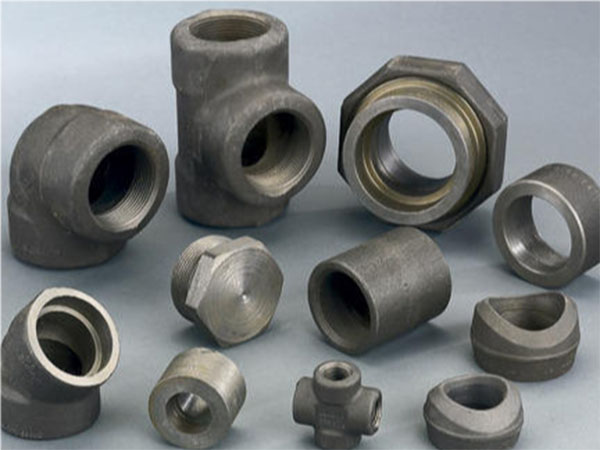Forged carbon steel pipe fittings are small-diameter high-pressure pipe fittings manufactured through forging processes. Usually, forging machinery is used to apply pressure to carbon steel billets, causing them to undergo plastic deformation, thereby obtaining forgings with specific mechanical properties, shapes and dimensions.
Forging process: By heating carbon steel billets at high temperatures and applying pressure with forging machinery to cause plastic deformation, specific shaped pipe fittings (such as elbows, tees, flanges, etc.) are formed.
Material: Carbon steel is adopted, with a carbon content typically ranging from 0.25% to 0.55%, featuring high strength and processability.
Standards: Common carbon steel material standards include ASTM A105, ASTM A182, ASTM A350 LF2, ASTM A694, etc. Forging accessory standards, including ASME B16.11, MSS-SP-79, MSS SP-83, MSS SP-95, MSS SP-97 and BS 3799 standards.

Size range: Nominal diameter 1/8 "- 4" (NB)
Pressure grades: Class2000 (2000psi), Class3000 (3000psi), Class6000 (6000psi), Class9000 (9000psi), among which 3M and 6M correspond to 3000psi and 6000psi respectively.
Connection methods: The main connection methods include threaded pipe fittings and socket welded pipe fittings. Threaded pipe fittings: NPT (ASME B1.20.1) or BSPP/BSPT and other threaded connections, facilitating on-site assembly and maintenance. Socket welded pipe fittings: Insert type pipe ends that need to be welded and fixed, suitable for high-pressure and high-vibration systems.
Threaded pipe fittings
Threaded pipe fittings are important accessories used in pipeline systems to connect pipes and equipment. Their characteristic is to achieve a tight connection of pipes through threaded connections. Threaded pipe fittings are mostly used for small-diameter pipes of DN 50 and below, and are commonly found in domestic water supply, fire protection and industrial cooling systems. The main forms include threaded elbows, threaded crosses, threaded tees, threaded pipe clamps, threaded pipe caps, threaded union joints, threaded short sections, reducer short sections, hexagonal external threads, threaded pipe plugs, threaded core fillers, etc.
Forged carbon steel threaded pipe fittings can be classified according to different situations. Classified by Angle, they can be divided into 45-degree and 90-degree elbows. According to the pressure classification, it can be divided into CLASS 2000, CLASS 3000 and CLASS 6000. According to the thread form, it can be divided into internal threads and non-external threads. High-pressure forged thread elbows generally adopt NPT thread form. Common thread forms include NPT, BSPP, BSPT, etc.
Socket welded pipe fittings
Socket pipe fittings are mainly formed by die forging blanks of round steel or steel ingots and then machined by lathes. They are a kind of high-pressure elbow pipe fittings. Its connection form is socket Welding (Socket Welding-SW), where steel pipes are inserted into the socket holes for welding.
Socket welded pipe fittings are fixed by fillet welds after being inserted at the pipe ends, providing higher strength and leakage safety. They are widely used in high-pressure, high-temperature and vibration environments in petrochemical, power, nuclear and other industries. The main forms include socket-welded elbows, socket-welded tees, socket-welded crosses, socket-welded couplings, socket-welded pipe clamps, socket-welded union joints, etc.
Comparison between forged pipe fittings and cast pipe fittings
Strength: Forged pipe fittings have higher strength and no internal defects, while cast pipe fittings have relatively lower strength and may have porosity, shrinkage porosity and other conditions.
Cost: The process of forged pipe fittings is more complex and the production cost is higher, while the process of cast pipe fittings is simpler and the cost is lower.
Surface quality: The surface quality of forged pipe fittings is smoother after forging process, while the surface quality of cast pipe fittings is relatively rough and requires secondary processing.
Summary: Forged carbon steel pipe fittings, with their high strength, pressure resistance and corrosion resistance, have become the preferred components for small-diameter high-pressure pipeline systems in industries such as petrochemical, power, metallurgy and shipping. Understanding its standards, materials, dimensions and various shapes can help engineering design and selection to be more precise and efficient.
Read more: Types and characteristics of common flanges
